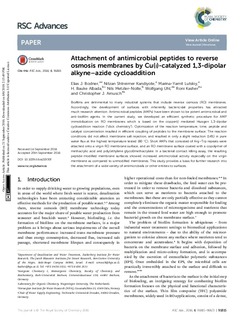| dc.contributor.author | Bodner, Elias J. | |
| dc.contributor.author | Kandiyote, Nitzan Shtreimer | |
| dc.contributor.author | Lutskiy, Marina-Yamit | |
| dc.contributor.author | Albada, H. Bauke | |
| dc.contributor.author | Metzler-Nolte, Nils | |
| dc.contributor.author | Uhl, Wolfgang | |
| dc.contributor.author | Kasher, Roni | |
| dc.contributor.author | Arnusch, Christopher J. | |
| dc.date.accessioned | 2018-08-06T13:30:26Z | |
| dc.date.available | 2018-08-06T13:30:26Z | |
| dc.date.issued | 2016 | |
| dc.identifier.citation | RSC Advances. 2016, 6 (94), 91815-91823. | nb_NO |
| dc.identifier.issn | 2046-2069 | |
| dc.identifier.uri | http://hdl.handle.net/11250/2507652 | |
| dc.description.abstract | Biofilms are detrimental to many industrial systems that include reverse osmosis (RO) membranes. Accordingly, the development of surfaces with inherently bactericidal properties has attracted much research attention. Antimicrobial peptides (AMPs) have been shown to be potent antimicrobial and anti-biofilm agents. In the current study, we developed an efficient synthetic procedure for AMP immobilization on RO membranes which is based on the copper(I) mediated Huisgen 1,3-dipolar cycloaddition reaction (“click chemistry”). Optimization of the reaction temperature, time, peptide and catalyst concentration resulted in efficient coupling of peptides to the membrane surface. The reaction conditions did not affect membrane salt rejection, and resulted in only a slight reduction (14%) in pure water flux at the highest temperature tested (80 C). Short AMPs that consisted of Arg–Trp repeats were attached onto a virgin RO membrane surface, and an RO membrane surface coated with a copolymer of methacrylic acid and poly(ethylene glycol)methacrylate. In a bacterial contact killing assay, the resulting peptide-modified membrane surfaces showed increased antimicrobial activity especially on the virgin membrane as compared to unmodified membranes. This study provides a basis for further research into the attachment of a wide variety of antimicrobials or other entities to surfaces. | nb_NO |
| dc.language.iso | eng | nb_NO |
| dc.publisher | Royal Society of Chemistry | nb_NO |
| dc.rights | Navngivelse 4.0 Internasjonal | * |
| dc.rights.uri | http://creativecommons.org/licenses/by/4.0/deed.no | * |
| dc.title | Attachment of antimicrobial peptides to reverse osmosis membranes by Cu(i)-catalyzed 1,3-dipolar alkyne-azide cycloaddition | nb_NO |
| dc.type | Journal article | nb_NO |
| dc.type | Peer reviewed | nb_NO |
| dc.description.version | publishedVersion | nb_NO |
| dc.rights.holder | © The Royal Society of Chemistry 2016 | nb_NO |
| dc.source.pagenumber | 91815-91823 | nb_NO |
| dc.source.volume | 6 | nb_NO |
| dc.source.journal | RSC Advances | nb_NO |
| dc.source.issue | 94 | nb_NO |
| dc.identifier.doi | 10.1039/c6ra21930f | |
| dc.identifier.cristin | 1450776 | |
| dc.relation.project | Israel Science Foundation: 1474-13 | nb_NO |

